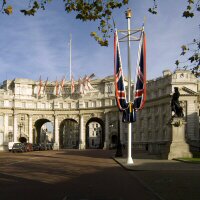Managing the Government's historic estate


The government and the wider public sector have an important role to play in managing their historic estates for current and future generations. As well as ensuring that their estates are ‘fit for purpose’ from an operational point of view, government bodies are under an obligation to protect any historic assets in their care for the wider public good. Historic buildings managed by central government range from barracks and airfields to prisons and courts. At the local level, they range from town halls and park buildings to police and fire stations.
All land and buildings in public ownership are liable to change to ensure more efficient delivery of public services. It is essential that any plans for alterations or development of any kind are based on a sound understanding of the special historic or architectural value of the asset affected. Where they become functionally redundant, historic assets need to be protected during the disposal process to ensure that the public interest – which includes cultural and communal benefits as well as financial returns – is optimised.
Central government has access to a specialist conservation advice service through the Government Historic Estates Unit. This page provides a gateway to the Unit’s advice and guidance. General guidance on the management of government property is available from the Office of Government Commerce part of HM Treasury.
Profile of the government historic estate
In England, there are seventeen government departments and agencies with historic estates, including 1,100 listed buildings. The Ministry of Defence (MoD) has the largest single historic estate with about 650 listed buildings plus 42 buildings that are protected as scheduled monuments; followed by the Ministry of Justice (which includes the court service and prison service). In addition, there are many more historic buildings on departments’ estates that lie in designated conservation areas, national parks, areas of outstanding natural beauty or world heritage sites.
- The MoD is a major land owner in rural areas. With an estate of 241,100 hectares across the United Kingdom, it has over 900 scheduled monuments on its training areas, with almost a third of these on Salisbury Plain. Further information on and on the MoD estate can be found on their website.
- The Forestry Commission owns an estate comparable in size to that of the MoD. It has approximately 872 scheduled monuments and 80 listed structures on its 250,000-hectare estate in England. This part of the Forestry Commission’s estate is managed by Forest Enterprise England.
- English Partnerships, the national regeneration agency, has a growing role in ensuring that surplus public-sector land is used to support wider government initiatives, such as improving the supply of affordable housing. Many of the brownfield sites on which it is promoting development, such as former hospitals, have heritage value.
- British Waterways (a public corporation) is responsible for the third-largest estate of listed buildings in the United Kingdom. In addition to 2,739 listed buildings, the BW estate includes or bisects 42 scheduled monuments, 5 world heritage sites, 8 historic battlefields, 12 registered historic parks, over 500 kilometres of conservation area and thousands of below-ground archaeological deposits.
- English Heritage (EH), a non-departmental public body, manages an estate which includes 405 historic sites open to the public, the majority held in guardianship or owned by the Secretary of State. Together with historic operational property, such as office buildings, EH is responsible for about 720 designated buildings and structures plus 45 London statues, 30 of which are listed. There are also 36 registered parks and gardens in English Heritage’s care.
- Historic Royal Palaces, the Royal Household and the Parliamentary Estates Directorate each manages estates in and around London which contain nationally significant buildings including the Tower of London and Hampton Court Palace (Historic Royal Palaces), Buckingham Palace and Windsor Castle (the Royal Household) and the Palace of Westminster (the Parliamentary Estates Directorate).
The Government Historic Estates Unit (GHEU)
GHEU is a team in English Heritage providing advice and guidance at a national level to government departments and agencies, as well as other bodies. It is part of the Planning & Development group in EH. The head of the unit is Will Holborow, who is supported by five other specialist staff and a team assistant.
GHEU’s policy work includes:
- liaising with government departments, agencies and other public bodies in relation to the management of their historic estates;
- setting and monitoring standards for the care of departments’ historic estates;
- producing the Biennial Conservation Report on the Government Historic Estate;
- providing training for departmental property staff;
- publishing conservation guidance for departments;
- maintaining records of the government’s historic buildings and monuments;
- advising departments on the selection of specialist conservation consultants;
- and carrying out work on behalf of English Heritage’s Research & Standards department, including management of the Fire Research Database (FreD).
GHEU provides informal site-specific advice:
- informal advice to departments at an early stage in the formulation of their development proposals;
- technical advice on repair and conservation projects, using specialist advice from elsewhere within EH where needed;
- advice on the commissioning and writing of management plans and conservation plans;
- monitoring the condition of all listed government buildings at risk and working with departments to find solutions for them;
- and advice on proposals where there are issues of national security.
GHEU handles statutory planning casework relating to specific government buildings, including offices in Whitehall and the naval bases at Portsmouth and Plymouth. It also deals with all casework relating to Historic Royal Palaces, the Royal Household and the Parliamentary Estate. GHEU responds to local planning authorities in respect of proposals affecting listed buildings, and to DCMS in respect of works to scheduled monuments.
GHEUEnglish Heritage
London EC1N 2ST
Tel: ; email:
Further details of the Unit's work and contact details for individual staff are available from the GHEU flyer.
What's New?
-
The National Heritage List for England is now live on the English Heritage website.
-
Welcome to the HER21 page. This page offers access to the full suite of HER21 project reports.
